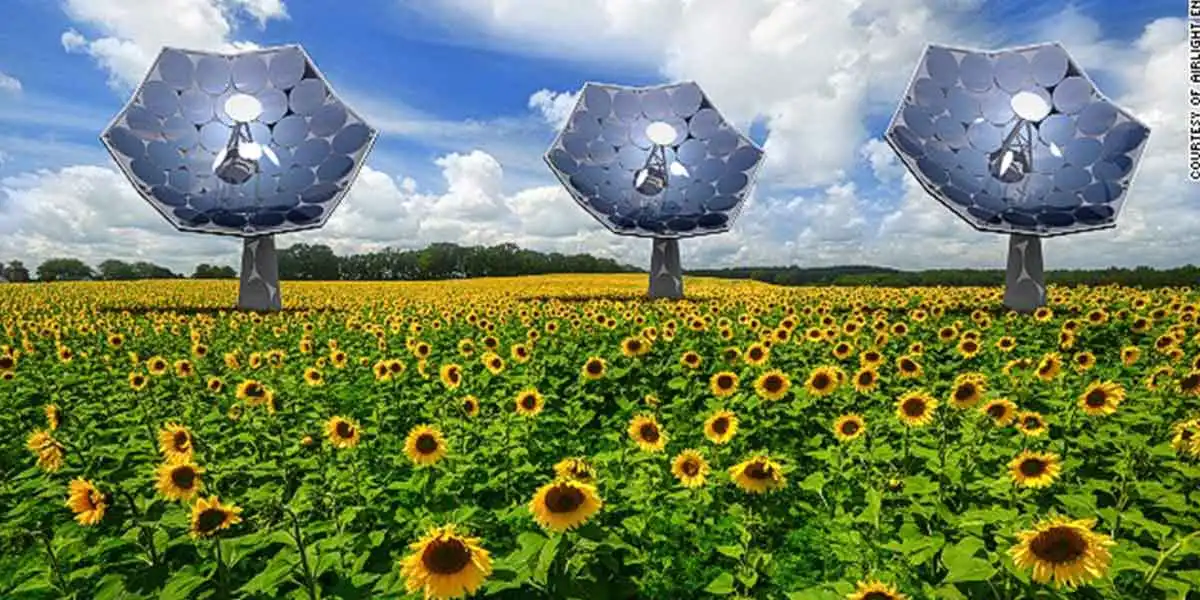
Sep 17, 2015
Blog Energy & Sustainability Flower Power May Bring Solar Electricity, Heating, Cooling, Even Water, to Remote Locations
Like all sunflowers, this one thrives on sunlight. It even tracks the sun’s path across the sky to maximize its angle of exposure. But this is no garden variety sunflower. It’s the Sunflower Solar Harvester, known scientifically as a High Concentration PhotoVoltaic Thermal system (HCPVT), which combines photovoltaic and thermal powers to harvest solar energy with 80 percent efficiency.
Developed by Swiss-based Airlight Energy and IBM Research, the Solar Sunflower can concentrate the power of “5,000 suns,” according to Ars Technica UK. The combination of photovoltaic solar power and concentrated solar power technologies enables the system to achieve a higher total efficiency than its comparators. The developers says their solar sunflower generates 12 kilowatts of electrical power and 20 kilowatts of heat on a sunny day—enough to power several average-sized homes—but at a cost that is two to three times lower than comparable systems.
Standing 10 meters tall, the HCPVT even resembles a sunflower. It uses a 40-square-meter parabolic dish that comprises 36 “petals” or elliptic mirrors made of recyclable plastic foil (about the thickness of a chocolate bar wrapper). The mirrored surface area concentrates the sun’s radiation by reflecting it onto several microchannel liquid-cooled solar panels, each of which is populated with an array of photovoltaic chips similar to those used on orbiting satellites. On an average sunny day, each chip produces an electrical power of up to 57 watts.
INNOVATIVE VASCULATURE COOLING SYSTEM BORROWS FROM IBM'S SUPERCOMPUTER COOLING SYSTEM
The solar panels are equipped with microchannels that pipe treated water within fractions of millimeters of the chips to absorb the excess heat that would otherwise damage the cells. The unique cooling system is 10 times more effective than passive air cooling, which boosts both the panels’ efficiency and solar-to-electricity conversion rate.
IBM already uses this direct hot-water cooling design in its high-performance computers. “The direct cooling technology with very small pumping power used to cool the photovoltaic chips with water is inspired by the hierarchical branched blood supply system of the human body,” said Dr. Bruno Michel, manager, advanced thermal packaging at IBM Research.
The HCPVT system also can be customized to provide drinkable water and air conditioning from its hot water output. For example, salt water can pass through a porous membrane distillation system, where it is vaporized and desalinated. According to developers, such a system could provide 30 to 40 liters of drinkable water per square meter of receiver area per day, while still generating electricity with a more than 25 percent yield or two kilowatt hours per day—a little less than half the amount of water the average person needs per day, according to the United Nations. By means of a thermally driven sorption chiller, cool air also can be produced.
“With the HCPVT we are ushering in a new generation of solar energy technology,” said Dr. Gianluca Ambrosetti, head of research, Airlight Energy. He envisions the all-in-one HCPVT system providing sustainable energy to arid and remote locations that require heating, cooling, and electricity.
The HCPVT, the components of which can be transported in a single container and reassembled on-site for immediate use, could be commercially available in 2017, noted CNN.
Related BCC Research reports:
Global Markets and Technologies for Photovoltaic Systems (EGY014J)
Building-Integrated Photovoltaics (BIPV): Technologies and Global Markets (EGY072B)
Catalysts for Environmental and Energy Applications (CHM020E)
Utility-scale Electricity Storage Technologies: Global Markets (EGY056C)
Global Markets, Technologies and Devices for Energy Harvesting (EGY097B)

Electrical switches—devices that control the flow of electricity—are the backbon...

As the world accelerates toward net-zero emissions, hydrogen, and ammonia have e...

Hydrogen technology is widely used across industries like glass, fertilizer, met...

We are your trusted research partner, providing actionable insights and custom consulting across life sciences, advanced materials, and technology. Allow BCC Research to nurture your smartest business decisions today, tomorrow, and beyond.
Contact UsBCC Research provides objective, unbiased measurement and assessment of market opportunities with detailed market research reports. Our experienced industry analysts assess growth opportunities, market sizing, technologies, applications, supply chains and companies with the singular goal of helping you make informed business decisions, free of noise and hype.